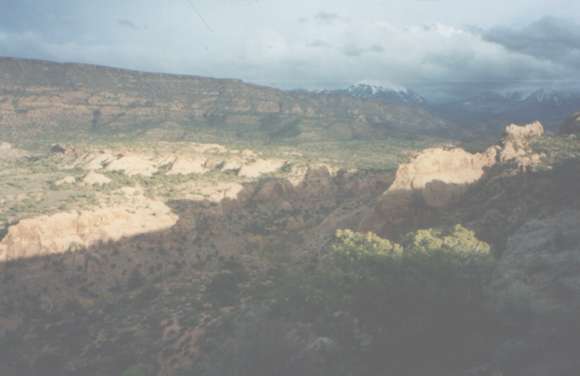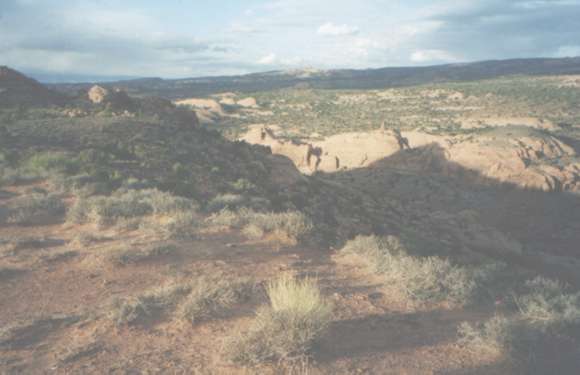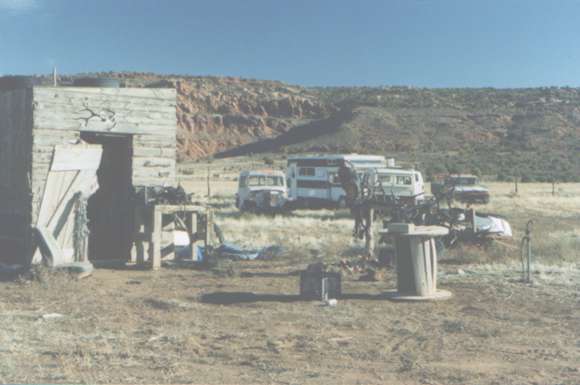

On November 3, 2000, the Moab Mesa Land Company (MMLC) submitted a sketch plan for the luxurious "Cloudrock Desert Lodge" to Grand County for review and approval. This accelerated a firestorm of controversy which started when county citizens discovered that the MMLC had signed a Letter of Intent (development agreement) for the project with the Utah School and Institutional Trust Lands Administration (SITLA) on September 12 after months of negotiations we did not know about. The development agreement with SITLA specified a massive resort hotel, condominium and luxury housing project would be built, making development approval seem a "done deal."
SITLA has repeatedly stated its lands are not subject to local zoning and land use codes. Many people in Grand County were irate because it appeared the county public was being given "an offer they could not refuse." This was a poor introduction for the Cloudrock Desert Lodge which could redefine the economy, tax base, and housing market of Grand County.
In my experience, the polarization of our community over Cloudrock is greater than that which occurred in 1987-88 over the proposed commercial hazardous waste incinerator, or the earlier controversy over locating the national high-level nuclear waste depository near Canyonlands National Park. Those past controversies pitted a toxic industrial economy against an economic future based on enjoyment (and preservation) of the area's environmental amenities by residents and recreationists. The Cloudrock controversy seems to pit those who want the Moab area to be a refuge from the economic striving and pollution of global corporate consumerism against those who want to profit from turning our area into a well-appointed refuge for the global economic elite.
The view from the rim of Mill Creek Canyon. If built, the Cloudrock Desert Lodge will be almost a mile long.
The Advocates
Advocacy for the nuclear waste depository and hazardous waste incinerator was concentrated in an aging leadership rooted in the uranium industry which collapsed in 1982. The leaders of the emerging tourist economy were often in opposition to these industrial-type developments if they thought the developments would harm our area's marketing image as a tourist destination. The advocacy for Cloudrock is strongest among community business leaders who are primarily involved in tourism services and real estate development. MMLC states that their initial promotional budget for the Lodge will be almost as large a sum per year as is spent by all other county promotional agencies combined. Simple math on the taxable value of the lodge, condos and housing indicate that Cloudrock Desert Lodge could easily be the largest property tax, sales tax, and transient room tax generator in the county when fully developed. Such a resort would not put a large tax burden on schools and law enforcement--the two largest consumers of local tax revenues. Advocates for Cloudrock see it as a tax base "cash cow" which will "jump start" recovery of the local tourist economy, which scared them by declining about 6% last year. Advocates also argue that high-end destination resorts have lower environmental impact than ordinary residential or commercial development.
The Opposition
Opposition to the earlier industrial development proposals primarily arose from public environmental values, but was not led by a core of environmental group members. Oppostion to Cloudrock is based on socio-economic concerns. Among Cloudrock opponents I observe two groups whose opposition arises from different issues.
Group A (for "Aspen") opposes Cloudrock because they fear that its promotional campaign directed to an economic elite will be successful, resulting in the Moab area becoming "ground zero" for the trophy house set. The dreaded result would be inflationary pressure on real estate, forcing the 80% of Grand County households with moderate, low, and very low income levels out of the Moab and Spanish Valley housing markets. Their nightmare scenario is described by Greg Bear in his song, "Boom Town:" "The rich build sensitive houses, and pass their shit around. The rest of us live in trailers on the outskirts of town. Cause we're livin' in a boom town..." Surrounded by federal lands, we don't have a low cost "outskirts of town" around Moab. One of the points of public consensus in 1996 and 2002 General Plan scoping sessions is that citizens value the diversity of the local cast of characters and the rural nature of the place we live (90% agree). Income, political, and lifestyle diversity are overwhelmingly identified as valued social amenities by current county residents. Group A opposes Cloudrock because they fear it will initiate economic changes which will wipe out the colorful diversity which is seemingly unique to Moab among rural Utah communities.
Group S (for "subsidization") opposes Cloudrock because: (1) they suspect that the development is absorbing low cost, high quality water and other infrastructure capacity that was "budgeted" to meet the development needs of existing, less wealthy landowners later. (2) they see Cloudrock receiving special treatment and favors from local government during the approval process. The basic philosophy of Group S can be said to be: "I have neither the right nor the desire to refuse to share Grand County with rich people, but I'll be damned if I'll pay for the privilege," and "Everybody has to play by the same rules."
Opposing Views of a Desirable Place to Live
The Cloudrock Desert Lodge proposal has brought out opposing worldviews about what constitutes a desirable place to live among our citizens. Cloudrock has become a symbol of what may realize, or ruin, that individual vision of a desirable place to live. Cloudrock supporters generally like economic growth and real estate value increases, and feel offense at junk, old mobile homes, and unkept yards. Cloudrock opponents favor a place which is live-and-let-live, with a slower pace of life and lower cost of living than cities, so people can pursue unconventional lives according to their tastes. In terms of a concept from an Eagles song, Cloudrock opponents prefer to "spend their money making time" to go enjoy the world, while advocates are more likely to enjoy spending their time making money.
The Cloudrock Desert Lodge Proposal
The approved Preliminary Plat for the Cloudrock Desert Lodge consists of a 225 room "Wilderness Lodge" located in a building slightly less than a mile long on top of a cliff overlooking the proposed Mill Creek Canyon Wilderness Area, 150 residential condominiums adjacent to the Lodge, and 110 homesites located in small clusters across the 1,935-acre Johnson's Up-On-Top mesa, leaving 79.9% of the mesa top unaltered "open space." The mesa is located on the east side of Spanish Valley, with its north end cupping the Moab Golf Course. The MMLC was formed by Michael Liss, formerly General Manager of Butterfield and Robinson (B&R), one of the top five adventure travel companies in the world. (B&R generally rates first in the world among travel companies in the hiking and biking tour category.)
The Cloudrock prospectus indicates that a million dollars in seed financing
for MMLC was provided by Paul Butterfield, with another $10 million in equity investment to be raised in minimum increments of $250,000 from investors. Investment solicitation will be first made to "B&R's 2000 elite Premiere Cru travelers."
The standard of luxury anticipated for the resort can be inferred by the three destination resorts MMLC cites as comparable: the Amanjena Marrakech, the Four Seasons Nevis, and the Four Season Ka'upulehu.
Development of the Cloudrock Desert Lodge complex is planned in four phases. The first phase, which is the only one "approved" by Grand County, is for construction of 48 rooms of the Lodge, plus support facilities such as restaurant, spa, offices, etc. Phase 2 consists of adding 27 Lodge rental units. Phase 3 adds 75 Lodge rooms, plus 75 condominiums and 55 employee housing units. Phase 4 adds the final 75 Lodge rooms and 75 condominiums. Curiously, the Preliminary Plat application makes no mention of the 110 homesites in the phases of construction table, although they are listed in the Table 1 description of the total project. 56 of the 110 homesites are to be clustered into "seven courtyard villages."
Grand County prescribed 24 conditions in the Preliminary Plat approval which have to be met before the County will accept a Final Plat for Phase 1 of Cloudrock. Until a developer is allowed to record a Final Plat for a development, he cannot obtain a building permit or sell lots in the development. The Preliminary Plat is, in essence, a contract between the county and the developer which specifies the conditions under which the county will accept the proposed development. In a large development, the county demands the developer show the total development plan so the county can evaluate density, infrastructure needs, and zoning code compliance for the whole. However, the Preliminary Plat approval which starts the land use code clock applies only to Phase 1; the developer has a year to make substantial progress towards meeting the development conditions for Phase 1 approval. If he does, he can get extensions of the approval in year increments. If he does not make progress, then the approval lapses. If the preliminary plat approval lapses, the developer has to start all over again with the review and approval process, and is subject to the land use code requirements that exist at the time a new development application is made. If and when Phase 1 conditions are met and the Final Plat is accepted by the county, then the developer may return to seek Preliminary Plat approval for Phase 2, which starts the performance clock for that phase.
SITLA and Taxes
Cloudrock Desert Lodge is located on land owned by the Utah School and Institutional Trust Lands Administration (SITLA). SITLA was created to administer lands granted to the State of Utah by the U.S. government at statehood to the benefit of the School Trust Fund. SITLA is not a part of either the executive or legislative branches of Utah government. The Utah Governor makes appointments to fill vacancies on the SITLA governing board, and the Utah Legislature reviews and approves the SITLA administrative budget annually. The Governor and Legislature otherwise have no say over the decisions SITLA makes concerning sale or lease of state trust lands.
Legally, those decisions can only be appealed on the grounds they failed to properly exercise SITLA's fiduciary responsibility to the School Trust Fund. In summary, if the SITLA board makes a decision that makes the most money possible off a piece of trust land, they've done their constitutionally-mandated job and anyone who doesn't like it can go fish.
The contract between MMLC and SITLA is very complex. In essence, it provides that the land that the Lodge and condominiums are built on will remain in SITLA ownership for a lease fee which is either a stated "floor" price or a percentage of MMLC revenue, whichever is greater. The homesites will be developed at MMLC's expense, but when sold to a buyer, SITLA will deliver a fee simple title to the lot to the buyer. When Cloudrock is fully developed, 220 of the 1,935 acres on Johnson's will be sold to home buyers and the rest will generate lease revenue for SITLA. The contract provides that, if MMLC decides not to proceed, or doesn't meet performance benchmarks in the SITLA contract, then SITLA acquires full rights to the approved development plan. This means that the Cloudrock Desert Lodge proposal has a life independent of Michael Liss and MMLC; if they don't build it, SITLA can substitute somebody who will.
Grand County is paid a small sum per acre for undeveloped SITLA land in a state equivalent to the Payment In Lieu of Taxes (PILT) program on federal lands in the county. When SITLA lands are leased for non-governmental development, the development is subject to a "privilege use fee" which is the same assessment by the Grand County Assessor on the value of improved land and buildings as is assessed on private property. SITLA land sold to homebuyers in Cloudrock is assessed and taxed just like any other privately-owned property in the county. Thus, land leased by SITLA to Cloudrock will generate just as much property tax to Grand County as the land would if Cloudrock bought it.
Attempting a Reality Check
Tax Base Cash Cow: In the event that Cloudrock was built out, it would be an overwhelming generator of property tax, sales tax, and transient room tax revenues in Grand County. It would also be a major employer. The wage rates are not known, but typically high-end destination resorts pay higher wages to staff because they need to retain able, dependable people to keep their discriminating, wealthy guests happy. Advocates' claim that Cloudrock represents about the most lucrative form of economic development possible is apparently true. Travelers and second home owners for this sort of high-end project will predictably deposit a lot of money in Grand County tax accounts while consuming relatively few tax-funded services.
Cloudrock as the Catalyst for "Aspenization": This is difficult to evaluate because there is no precedent to a Cloudrock-type development elsewhere in an equivalent location. In Aspen, Telluride, Santa Fe, Sedona, et al, the high-end resorts and buy-in of the rich first occurred in the historic center of town. Where private lands are available around the historic center, as in Santa Fe, mobile home parks and middle-class housing developments occur on the outskirts of town. Where public or unbuildable lands surround the town, as in Aspen and Telluride, lower-income people are displaced to other counties and towns.
In Grand County, the population center of Moab is where the most affordable housing is located. Most higher-end residential development has occurred in Castle Valley and the edges of Spanish Valley. Cloudrock is located on a mesa top about 20 minutes drive from downtown Moab. Most of Cloudrock's promotional budget will be directed to travelers, not potential residents. Most of the buyable residential units in Cloudrock will be condominiums which are part of the Lodge complex. These will be rented and maintained by Lodge management for the unit owners, making the condominiums de facto rental suites rather than homes for new Grand County legal residents.
Grand County does not have the winter sports and cool summer environment, or the rich buffet of arts, which other communities colonized by the rich had to offer. I think Michael Liss knows his marketing very well, and is targeting active adventure travelers. How many of these would care to become county adventure residents is unknowable, and whether Cloudrock's promotion would arouse inflationary pressure on real estate on "poverty flats" (the actual name for Spanish Valley at the turn of the century, with a post office by that name!) below the mesa escarpment is unpredictable. The hodge-podge of 30-year-old house trailers, cheap miner's housing, and metal buildings around Moab make existing residential areas an unlikely bidding target for rich people wanting sites for trophy homes.
In summary, Cloudrock Desert Lodge is a "colonization" proposal for creation of an isolated, self-contained refuge for the well-off adventure traveler. As such, it may have no more inflationary or political impact on Moab real estate than the White Mesa Ute Reservation has on Blanding's property values.
Subsidization: This issue was extensively addressed by Grand County, which is mindful of our citizens' mandate in the General Plan that development should pay its own infrastructure costs. In the 1996 Capital Infrastructure Plan, which addressed buildout infrastructure needs and costs in Spanish Valley and Moab City, we assumed some of SITLA's lands would be developed. We budgeted water, sewer, road, and other capacities to SITLA lands at a development density of one Equivalent Residential Unit (ERU) per 12.6 acres of SITLA land.
Thus, our water system design assumed 153 ERUs on Johnson's Up-On-Top mesa, and the expansion of the Spanish Valley Water and Sewer Improvement District system currently being built contains that capacity. Phase 1 development of 48 lodge rooms and 8,800 square feet of food service represents 25 ERU's of water and 55 ERU's of sewer capacity.
A Spanish Valley scene, with Johnson's Up on Top in the distance.
Both Phase 1 and 2 of Cloudrock can be built out within the 1995 infrastructure budget. In 2002, we are updating the Capital Infrastructure Plan, and will address ERUs of demand from Cloudrock not covered by the 1996 infrastructure plan. Outside of culinary water, which is provided by an independent water retailer and not county government, the county's conditions of approval for Cloudrock specify that MMLC has to payall impact fees and any extraordinary costs of development service beyond those covered in our impact fees.
Grand County has not, to my knowledge, given MMLC a single financial break or inducement. They confront paying the same costs as any other developer or local citizen. Further, the way the county approval of Cloudrock is structured, the county can refuse to approve any phase of Cloudrock development for which service capacity is not then available in fact.
Whether Cloudrock is built at all, and how much of it is built, will depend on MMLC's ability to raise millions in equity capital, and the amount of market demand they can generate if and when they have the Lodge open. The target customers for Cloudrock are less affected by economic changes than middle and lower class customers, so a doubling of fuel prices which might cut national park visitation by 30% would predictably have little effect on Cloudrock's clientele. But will Cloudrock's potential clientele want to buy what Cloudrock has to offer when they can afford to go anywhere they want to? Will investors think so? Can Mr. Liss convince investors to pony up at least a quarter million each when he has no more experience building and operating a luxury destination resort than I or Jim Stiles do? We can only wait and see.
Lance Christie can be reached at: att@lasal.net










